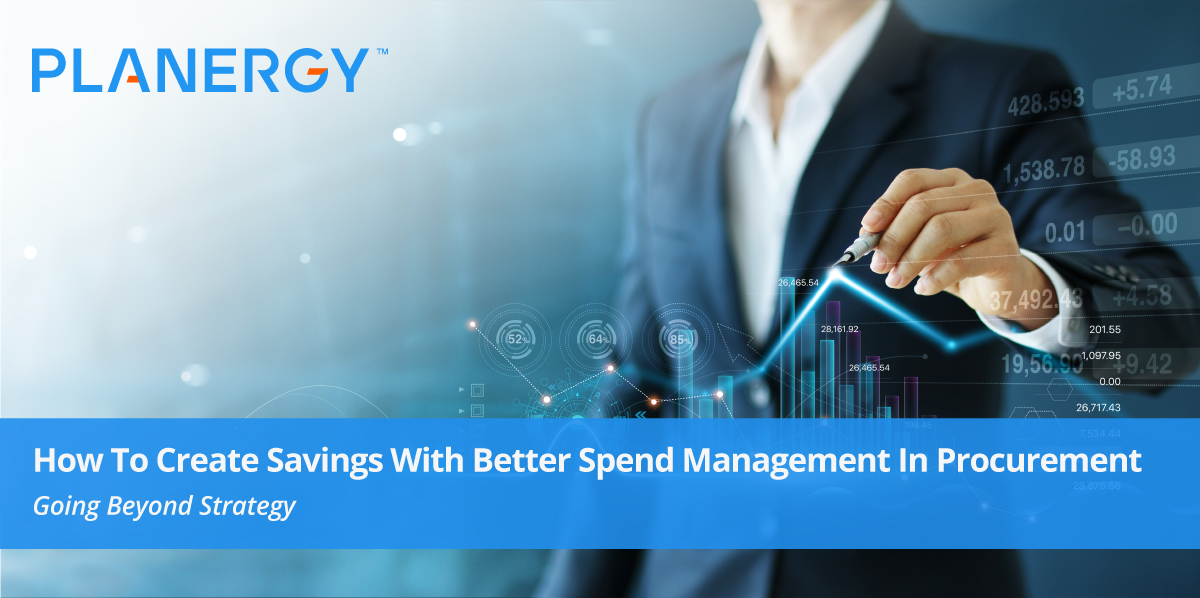Before we can explore how to increase your savings with better spend management, we must first take a look at what spend management is.
Spend management refers to the process of collecting, maintaining, categorizing, and reviewing spend data in an effort to reduce procurement costs.
It also aims to improve efficiency, monitor and control workflows, and maintain regulatory compliance.
The spend management process affects numerous activities throughout the procurement cycle including requisition processing, planning, budgeting, supplier and contract management, Inventory management, sourcing, and even product development.
All organizations, regardless of their size and type, should develop a spend management process.
An optimized spend management process can result in 90%+ in operational efficiency savings.
Here, we’ll explore how spend management optimization creates savings and the steps you need to take to reap those rewards.
Review Your Spend Management Process
What does your current spend management process look like? You may have tightly managed processes with a number of disparate tools.
You may have a loosely managed process using disparate tools. But, the truth is that many companies don’t have any process in place at all.
PLANERGY recently dealt with a public company with $50 million in spend with no system in place.
Benchmarking their spend/revenue ratio against a peer group found that their spend was 25%, while the industry average was 16.5%.
That’s almost a 10% increase in spend, due to the lack of a cohesive spend management process.
Follow Best Practices in Spend Management and Analysis
Having a process is a good start, but you need to analyze it to make sure it follows best practices.
This means it:
- Is a centralized platform
- Gives you full spend transparency
- Integrates with your accounting software or ERP
- Manages the full Procure-to-Pay lifecycle
- Prevents just anyone in the organization from buying something without using the system
- Allows for users to have the necessary permissions to avoid approval bottlenecks
- Has budgets that are allocated to mirror a signing authority matrix
- Allows you to implement appropriate approval workflows
- Offers accounts payable automation
- Includes three-way matching for better risk management
- Makes it easy to benchmark vendors for delivery, pricing, availability, and more
- Has real-time reporting and alerts for early payments and late payment penalties
Chances are your current spend management strategy doesn’t hit on all these marks – and that’s okay.
What matters is that you move away from a manual approach full of spreadsheets, phone calls, and emails, to a dedicated Procure-to-Pay Software that centralizes everything.
Why a Centralized Repository
Organization is key for any business. By storing information in a single location, there’s no more sifting through emails, hoping you’re working from the latest version of the Excel spreadsheet, or playing phone tag.
Users get access to the information they need when they need it. And with all relevant documentation – vendor invoices, contracts, etc. – everybody will be on the same page.
Files can be added to vendors, along with a full catalog of the products they offer, to speed up the ordering process.
In some organizations this will allow for better control where needed, but all organizations will benefit from the transparency in their procurement process.
Why Accounting Integration Matters
Whatever spend management or procurement platform you use it should also integrate with your accounting software or ERP.
Why? The manual process takes time and is full of error potential. AP automation saves up to 80% of the time your team spends processing invoices and prevents you from making costly mistakes such as:
- Paying duplicate invoices
- Paying for items invoiced, but not received
- Paying for items invoiced, but received damaged or unusable
- Missing the opportunity to leverage early payment discounts
- Paying multiple invoices late, subjecting the company to late fees and damaging supplier relationships
If you’re spending 10 hours per week on AP, switching to automation could cut that down to two hours. Imagine what your team could do with an extra eight hours every week.
The accounting software integration also ensures that you can manage the entire Source-to-Pay lifecycle.
No more having to scan invoices into the accounting system and matching them up to the appropriate purchase order manually.
By connecting your eProcurement software to your accounting solution, you can take advantage of three-way matching.
This feature automatically checks your invoice against goods received and the approved purchase orders.
This way, you’re only paying for items you’ve ordered and received. If there’s a mismatch anywhere in the system, it gets flagged for human intervention.
For instance, if your PO contained an order for 17 new computer desks, and only 10 have been received, you’ll receive an alert before paying an invoice for all 17.
You can then check to make sure there’s not a separate shipment you’re waiting on, or that 7 desks didn’t arrive damaged.
Depending on what you find, you can reach out to the supplier to correct the issue, and submit a partial payment for what you’ve received.
A more streamlined accounts payable process also can improve your relationships with key suppliers.
Enabling you to pay on time keeps them happy but can also realize savings from early payment discount agreements or avoiding late payment penalties.
3-way matching also removes invoice approval bottlenecks caused by lack of data when using a standalone AP Automation software.
With a solid spend management process comes better spend visibility. And with that, you have better decision-making capabilities.
User Permissions and Approval Workflows
If your current process makes it easy for anyone to purchase anything, without having to go through a specific process or software, you’re in trouble.
Your business could be losing tons of money through maverick spend – or purchases made outside of your company’s designated purchasing process, duplication of orders.
Profit leak in spend management is often death by 1,000 cuts and without spend visibility and correct approval workflows this can add up to big overall impact on cash-flow and profit.
With user permissions, you can designate certain capabilities to each employee based on what their job function requires.
Department heads may be in charge of approval at one level, where certain thresholds require approval from the department head and their supervisor.
Whereas the office manager may be able to approve certain types of indirect spend like office supplies. Some basic supplies or dollar amounts may not require any approval.
How you set up user permissions and approval workflows depends on the nature and size of your business.
However, granular controls ensure that each department follows budgets, and can even limit purchases to certain suppliers or products for better category management.
The approval workflows ensure that no purchase requisitions or purchase orders sit in a pile or get lost on someone’s desk as it moves from one person to another.
With workflow rules, you can set spending thresholds, individual item dollar amounts, etc. to determine who has to approve what and when.
Reporting and Forecasting
Sure, reporting can be done with Excel, if you’re a whiz when it comes to formulas.
But, when you’re working with multiple people and multiple versions of the same data, you can’t be sure you’re dealing with accurate spend data – and that can throw a wrench in things.
Real-time reporting and spend analysis are crucial for managing a company’s spend.
The spend analytics data is a key part of spotting savings opportunities, making data-driven decisions, and even improving supplier management.
If reporting finds that you’re spending more in certain spend categories than you expected, you can dig deeper to find the root cause.
Is it because a supplier you contracted with as part of your strategic sourcing initiative isn’t holding up their end of the deal? Is it because costs are higher than you initially planned for? Is it because your previous approval process allowed for unnecessary spending?
Whatever the case may be, the report data can help you and stakeholders determine the next course of action to help you reach your business goals.
Data management based on historical spend is important to help you see how you’ve done in the past, but report and data standardization can also be helpful when it comes to forecasting the future.
For instance, if business stays relatively the same from month to month, you can compare sales data to the prior month to determine profitability.
You look for ways to save money and reinvest it in other areas of your business. Seasonal businesses can use year over year comparisons for the same thing.
Effective Spend Management Starts with Digital Transformation
To keep up with your competition, you must have a solid procurement strategy. But if that procurement strategy doesn’t involve using digital tools to help procurement teams, then you won’t be able to execute that strategy to the best of your ability.
Procurement process optimization begins by analyzing what you’re currently doing and finding ways to improve it.
You can’t get to where you’re going if you don’t know where you are.
It’s only when you have the right spend management solution in place that you can start to reap the cost savings.
When you take money you save and combine it with the time your procurement and AP teams save, you’ll be able to invest in other initiatives that improve your cash flow and your bottom line.




